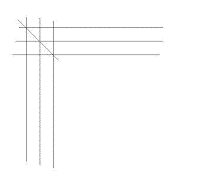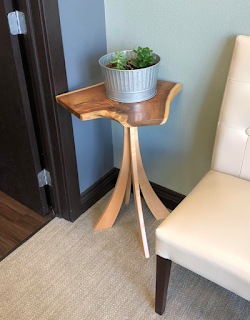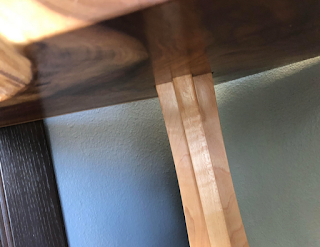Really, I clicked a link to another Blogger blog, and discovered it had been hijacked, so I wanted to verify that my old blog was still working. Whew!
If your blog or website was hijacked, this article is pretty good:
https://blogging.nitecruzr.net/2012/11/use-well-protected-browser-to-block.html
Lately I've been looking at two types of projects - Trestle dining room tables and desks, and side tables - mostly of the smaller size.
This table caught my eye yesterday:
...as I had never seen legs like that before.
I also liked the way it was fastened to the slab top:
As you can see, it is fully mortised into the slab top, no visible fasteners. Just fine for a plant!
Yes, next time I'm at the dentist's office, I'm going to have to ask about the woodworker that made.
Cheers!
Thursday, October 4, 2018
Thursday, April 15, 2010
Reproduction Stickley hardware #3
I thought after the last Reproduction Stickley hardware entry that I was done with the subject. But, found one more set of instructions on how to roll your own Hand-Hammered Copper hardware. The first entry I did on this topic had a link to a different guide. Personally, I think they are both worth reading. The lead picture from the article is shown at the left. I sure hope this constitutes Fair Use as my only purpose in displaying it is to tempt you into reading This Great Article on the American Woodworker Magazine website on how to make the hardware for yourself! Hammer Your Own Copper Hardware by David Olson is well worth reading, as is the companion article by Randy Johnson on building a Stickley style chest of drawers. Yes, to get these results a fair bit of work is going to be required, but, I think worth trying, at least once.
Thursday, April 1, 2010
Saving woodworking articles for later viewing, Part 2
If you have a Macintosh, you can simply "print" to a PDF printer - and that includes interesting articles that you've stumbled upon on the Web. If you are a PC (user) then there isn't a native method to do this. (See Part 1 for native methods to save webpages.) However, for the last few months, I've been using PrimoPDF, a free print-to-PDF driver that is added to your printer selection combobox. I especially like being able to highlight something and then print just that selection to a PDF file. PDF is an acronym for Portable Document Format. Like an MHT file, it stores everything you need in one file. A nice thing about PDF files is that they can be viewed on any machine (the first word in the name is Portable, after all.) On a PC, the best way to view PDF files is by using Adobe Reader (also free!) which used to be called Acrobat Reader. So, if you aren't afraid to install two pieces of software, ignore everything I said in Part 1!
Labels:
Adobe,
Adobe Reader,
IE,
Internet Explorer,
MHT files,
Microsoft,
PDF,
PrimoPDF,
webpages
Monday, March 1, 2010
Is plywood a fine woodworking material?
Our friends at the Fine Woodworking magazine website took this "issue" on.
The article HERE was good, but the comments were almost a better read than the article itself. The two pictured casework pieces are a delight to look at, so even if you don't read the article, follow the link for the pictures! The picture I am showing you is not from the article, but from Timber Products. They make not only hardwood veneer plywood, but pre-finished plywood as well.
Personally, I thought the Fine Woodworking list of helpful tips was pretty good, but the last one: "Delivery pays: Let the supplier deliver hardwood-veneer plywood to reduce the risk of damage in transit" didn't sit well with me as you are stuck with the grain they pick for you - rather than picking through the sheets to get the figure you want from what is available. Or, if you have hand picked your sheet goods, the variability of turning it over to their delivery people...
I'm pretty careful with my material when I've spent hard earned money on it. Not a fan of mangled corners and dented edges, not to mention strap marks on the wood. One commenter got it right - if whoever you are buying plywood from has a panel saw (even Lowes and Home Depot have them) have them make some of the gross cuts there, so you are transporting smaller easier to manage pieces - especially if the cuts you need are rip cuts, because once a panel saw is locked in, it will give you near identical repeat cuts - which can be handy when what you need is a match between two pieces, not an exact / dialed in perfect measurement. But, you have to be careful - if you are using the pretty cathedral grain for panels, you may want to make grain match decisions back in the shop, not in the store.
The Fine Woodworking article / discussion thread really caught my eye as a couple of the projects I helped work on lately have been predominately of plywood, with solid wood trim. The one thing against plywood is that it is as flat is it is every going to be, the day you buy it. If the juice is good, it will stay good. If not... ...well there really isn't anything you can do about bad plywood. And, to some extent with hardwood, there Are things you can do about it.
What I really didn't like is the (results pictured) POLL that went along with this article. No concept that perhaps sometimes plywood was the right material? That the only possible reason to use plywood would be to save a dime, or for lesser purpose? It seems especially silly as a lot of people that turn their noses up at plywood are proud of their veneering skills -which is the art of making (you guessed it) plywood. Anywho, a lot of this is in the comments to the online article. But I really wish that at least the poll questions had better balance. I was glad to see that people weren't bullied into rejecting plywood in the poll, based on their responses to the questions. But then if the questions were fair, there probably wouldn't have been the active commenting! (grin)
The article HERE was good, but the comments were almost a better read than the article itself. The two pictured casework pieces are a delight to look at, so even if you don't read the article, follow the link for the pictures! The picture I am showing you is not from the article, but from Timber Products. They make not only hardwood veneer plywood, but pre-finished plywood as well.
Personally, I thought the Fine Woodworking list of helpful tips was pretty good, but the last one: "Delivery pays: Let the supplier deliver hardwood-veneer plywood to reduce the risk of damage in transit" didn't sit well with me as you are stuck with the grain they pick for you - rather than picking through the sheets to get the figure you want from what is available. Or, if you have hand picked your sheet goods, the variability of turning it over to their delivery people...
I'm pretty careful with my material when I've spent hard earned money on it. Not a fan of mangled corners and dented edges, not to mention strap marks on the wood. One commenter got it right - if whoever you are buying plywood from has a panel saw (even Lowes and Home Depot have them) have them make some of the gross cuts there, so you are transporting smaller easier to manage pieces - especially if the cuts you need are rip cuts, because once a panel saw is locked in, it will give you near identical repeat cuts - which can be handy when what you need is a match between two pieces, not an exact / dialed in perfect measurement. But, you have to be careful - if you are using the pretty cathedral grain for panels, you may want to make grain match decisions back in the shop, not in the store.
The Fine Woodworking article / discussion thread really caught my eye as a couple of the projects I helped work on lately have been predominately of plywood, with solid wood trim. The one thing against plywood is that it is as flat is it is every going to be, the day you buy it. If the juice is good, it will stay good. If not... ...well there really isn't anything you can do about bad plywood. And, to some extent with hardwood, there Are things you can do about it.
What I really didn't like is the (results pictured) POLL that went along with this article. No concept that perhaps sometimes plywood was the right material? That the only possible reason to use plywood would be to save a dime, or for lesser purpose? It seems especially silly as a lot of people that turn their noses up at plywood are proud of their veneering skills -which is the art of making (you guessed it) plywood. Anywho, a lot of this is in the comments to the online article. But I really wish that at least the poll questions had better balance. I was glad to see that people weren't bullied into rejecting plywood in the poll, based on their responses to the questions. But then if the questions were fair, there probably wouldn't have been the active commenting! (grin)
Labels:
Fine Woodworking,
Home Depot,
Lowes,
Panel Saw,
plywood,
poll,
Timber Products Co,
veneer
Tuesday, February 16, 2010
How to Ruin Perfectly Good Furniture, part 1
There IS one more way to ruin furniture that doesn't match directly up with the above categories and that is to purposefully damage finish or piece itself to "antique" it... ...and that is where the rant part comes in. I don't like fake antiques. Never have, never will. Reproductions? Wonderful. Aging metal hardware? Fine. Banging on otherwise perfectly fine furniture to make it look worn? HELL NO!
If you need a particular piece to look a certain way for a play, or a movie set, or you make props for Halloween - well, those are the only exceptions I can think of. But then, we are talking about my personal taste. Your mileage may vary. As you may guess, I'm not a "shabby chic" guy either, even when someone is decorating with "found" junk.
People use words like "distressed" or "layered" as euphemisms for damaging on purpose. The above photo of a crackle finish was done on purpose! Ugh. Please look at this cover of a nationally circulated Woodworking Magazine. I can't post it directly on this blog because, well; I won't do it. Too Hideous. It isn't even good "antiquing". It is the poster child of what not to do, even if you like that kind of crap. But, I do want you to see the picture so you can share my disgust. Ok, end of rant. I'll try to be more productive in the next installment.
Labels:
Antiques,
Antiquing,
Crackle Finish,
Distressed,
Layered,
Reproductions,
Ruining Furniture
Monday, February 8, 2010
Oak Floor, Walnut accent
My friends Donna and Mike have been making incremental improvements to their 40 year old house ever since they bought it. Their latest project was to replace the dark Oak parquet floor in their entry and first floor hallway and to replace the Linoleum in their kitchen all with Oak strip flooring to match their dining room and living room. To address wear concerns, they opted for a tiled entry, placed as a inlay with oak flooring around it.
 One of the questions was how to best frame the area where the tile would go / how to make the transition. The initial thought was to make a mitered corner two-strip-wide border, to effectively picture frame the tile. As I was drawing out the lines for this framing / showing how it would look on the membrane paper that goes between the flooring and the subfloor, Donna came through and saw lines marked on the paper like this and said "how pretty!" She wasn't seeing what Mike and I were seeing - she saw corner blocks with angled cuts, out of contrasting wood, where we saw mitered corners & continuation lines to mark out the miter. So, as a trial, we cut small square blocks of Oak from the scrap offcuts of the flooring and used dark markers to simulate the contrasting colors of an accent wood like Walnut.
One of the questions was how to best frame the area where the tile would go / how to make the transition. The initial thought was to make a mitered corner two-strip-wide border, to effectively picture frame the tile. As I was drawing out the lines for this framing / showing how it would look on the membrane paper that goes between the flooring and the subfloor, Donna came through and saw lines marked on the paper like this and said "how pretty!" She wasn't seeing what Mike and I were seeing - she saw corner blocks with angled cuts, out of contrasting wood, where we saw mitered corners & continuation lines to mark out the miter. So, as a trial, we cut small square blocks of Oak from the scrap offcuts of the flooring and used dark markers to simulate the contrasting colors of an accent wood like Walnut.
 Even with the blocks rotated into the kite pattern you see here at the left, it wasn't exactly what they were looking for, but they still liked the idea of some form of contrasting wood detail around the entry. What they decided on was solid squares of Walnut, 2 per corner.
Even with the blocks rotated into the kite pattern you see here at the left, it wasn't exactly what they were looking for, but they still liked the idea of some form of contrasting wood detail around the entry. What they decided on was solid squares of Walnut, 2 per corner.
Making the little Walnut blocks was interesting - 2 sides tongue, 2 sides groove (to tie in with the tongues and grooves of the rest of the flooring) and I tried to gang cut them on the table saw as much as possible & then cut the joining tongues apart as the last operation. Still, getting the blocks sized correctly took a lot of time! Cutting the blocks without tongues or grooves would have taken just a few minutes instead of the few hours. But, hopefully the floor will be more solid because of the pains we took. I made a total of 14 blocks out of a small board of figured Walnut I had been hoarding and they selected their 8 favorites for appearance / grain direction, etc. And the results look like this:
At the point this picture was taken everything is finished except for the molding. The Oak register covers look great and Donna and Mike have a seamless Oak floor for much of the first floor. The flooring matched very nicely with the original Oak after it was sanded and finished as the one floor it now is. They selected Swedish Finish for its durability. It really looks nice. Oh, in the tile work, note the stainless steel accent tile in the lower right of this picture. They used a similar tile pattern to cover the bricks of their living room fireplace surround - it really helps tie everything together & looks great. So, I suppose the lesson in this is that it really helps to have multiple sets of eyes on a project, before you start cutting wood. Without Donna's perception, this would have been a much plainer floor!
Making the little Walnut blocks was interesting - 2 sides tongue, 2 sides groove (to tie in with the tongues and grooves of the rest of the flooring) and I tried to gang cut them on the table saw as much as possible & then cut the joining tongues apart as the last operation. Still, getting the blocks sized correctly took a lot of time! Cutting the blocks without tongues or grooves would have taken just a few minutes instead of the few hours. But, hopefully the floor will be more solid because of the pains we took. I made a total of 14 blocks out of a small board of figured Walnut I had been hoarding and they selected their 8 favorites for appearance / grain direction, etc. And the results look like this:
At the point this picture was taken everything is finished except for the molding. The Oak register covers look great and Donna and Mike have a seamless Oak floor for much of the first floor. The flooring matched very nicely with the original Oak after it was sanded and finished as the one floor it now is. They selected Swedish Finish for its durability. It really looks nice. Oh, in the tile work, note the stainless steel accent tile in the lower right of this picture. They used a similar tile pattern to cover the bricks of their living room fireplace surround - it really helps tie everything together & looks great. So, I suppose the lesson in this is that it really helps to have multiple sets of eyes on a project, before you start cutting wood. Without Donna's perception, this would have been a much plainer floor!
Labels:
Donna,
flooring,
Glitsa,
Mike,
Oak Floor,
Stainless Steel,
Swedish Finish,
Tile,
Walnut
Tuesday, February 2, 2010
try Hide Glue, epoxy, and repairability
I've been addicted to Titebond II since it came out, and based on my success with it, use quite a bit of Titebond III now too. They both create amazing bonds to the wood, to the point where I wonder if mortice and tenon joints are just overkill and do we really need more than half-lap joints? In tests I've seen in the last few years, the wood tends to fail before the glue does!
However, what about repairability? A lot of people talk about hide glue (the original woodworkers glue and still the choice of Luthiers / instrument makers) as being the best / only repairable glue joint. Bob Smalser did a test of the various glues, but to "repair" he use epoxy and discovered that none of the Titebond glues create good bonds to epoxy. Epoxy being the most likely glue to use to repair a failed joint. Of course his criteria for repairability is that of a boat builder / restorer, where joint strength and watertight are both equally important, and water based glues such as hide glue is right out! So, his test involved just glues that a boat builder might reasonably use.
As an aspiring furniture maker I have been wondering about hide glue though. Sure, it isn't the glue of choice for even kitchen cutting boards, but hide glue is the traditional glue of woodworking, and the best choice for repairing antiques. The reason that hide glue is so cool is that it is waterbased and reversible. Simply get the glue wet again and it turns back into gel. Get it warm again and it turns back into runny glue.
Most everything you need to know about hide glue is available on Frank Ford's www.Frets.com website.
Something that I've seen in a few different places is an easy way to try Hide Glue out. Gelatine - like Knox unflavored Gelatine available in nearly any supermarket IS hide glue. Gelatine is super refined for food use, but still Hide Glue. Sandor Nagyszalanczy talks about it in his book: Fixing and Avoiding Woodworking Mistakes, as does Frank Ford on his website in his Kitchen Glue page.
I probably won't try hide glue until necessity requires it - which will be the next time I'm faced with repairing an antique originally made with Hide Glue, or, when I want to reinforce a joint with a rubbed glue block. But, good to have in our bag of tricks.
However, what about repairability? A lot of people talk about hide glue (the original woodworkers glue and still the choice of Luthiers / instrument makers) as being the best / only repairable glue joint. Bob Smalser did a test of the various glues, but to "repair" he use epoxy and discovered that none of the Titebond glues create good bonds to epoxy. Epoxy being the most likely glue to use to repair a failed joint. Of course his criteria for repairability is that of a boat builder / restorer, where joint strength and watertight are both equally important, and water based glues such as hide glue is right out! So, his test involved just glues that a boat builder might reasonably use.
As an aspiring furniture maker I have been wondering about hide glue though. Sure, it isn't the glue of choice for even kitchen cutting boards, but hide glue is the traditional glue of woodworking, and the best choice for repairing antiques. The reason that hide glue is so cool is that it is waterbased and reversible. Simply get the glue wet again and it turns back into gel. Get it warm again and it turns back into runny glue.
Most everything you need to know about hide glue is available on Frank Ford's www.Frets.com website.
Something that I've seen in a few different places is an easy way to try Hide Glue out. Gelatine - like Knox unflavored Gelatine available in nearly any supermarket IS hide glue. Gelatine is super refined for food use, but still Hide Glue. Sandor Nagyszalanczy talks about it in his book: Fixing and Avoiding Woodworking Mistakes, as does Frank Ford on his website in his Kitchen Glue page.
I probably won't try hide glue until necessity requires it - which will be the next time I'm faced with repairing an antique originally made with Hide Glue, or, when I want to reinforce a joint with a rubbed glue block. But, good to have in our bag of tricks.
Labels:
Epoxy,
Gelatin,
Gelatine,
glue joints,
Hide Glue,
Luthier,
repairability,
repairing antiques,
Titebond
Subscribe to:
Comments (Atom)







